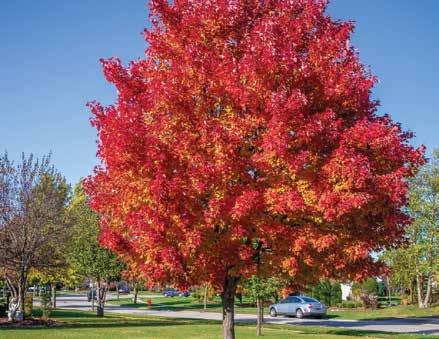
4 minute read
Ask the Experts
Pond Shoreline Erodes
Question: I live along the pond in my HOA, watching as the bank slowly erodes. I am concerned about my property. How can this issue be resolved?
Answer: Dealing with water erosion is not always easy with a simple fix. I have learned Mother Nature usually wins. There are few options, and most will come with a price tag. The waves and force of the water cause the edges to cave off or erode. One option is to regrade the slope, making it gentler and more like a beach, instead of a “wall” of soil. Another option is to line the pond edge with rip rock or gabion baskets. Larger boulders of rock act as a buffer between the unstable soil and the water. Rip rock is basically an edging of rock, while the gabion baskets are blocks of rocks used to create an edge. No matter the option, a company will need access to the pond edge to place the rock or grade.
Plant materials such as native grasses may slow erosion, but the force of water will continue to undermine the soil and cause erosion.
When To Prune Red Maple
Question: I have a 10-year-old red maple. When should this tree be pruned?
Answer: Maples and several other species are often referred to as bleeders. A bleeder is a tree that tends to ooze excess sap when pruned in late winter before leaf development. Red maples pruned in late winter, as the sap starts to flow, will often drip sap from the cuts for some time after pruning.
The sap bleeding does not harm the tree, nor will it bleed itself to death. The sap is just messy and causes concern. Maples, birch, and walnuts will bleed less if pruning is delayed until after the foliage has developed. Pruning either during the dormant season or after leaf out is acceptable. Just be prepared for the potential sap flow. It will stop, and there will be no long-term concerns with the tree’s health if a proper pruning cut is made.
Improving Germination
Question: I attempted to grow a vegetable transplants for the garden this winter. I had poor germination. What can I do to improve germination?
Answer: Growing your own transplants can be rewarding but frustrating. It helps me to think about growing transplants in two steps. The first is germination, and the second is the growth phase. The requirements are slightly different.
Poor germination may be related to either cool soil conditions or uneven moisture. Germination is greater and more rapid when the soil mass is kept at 70 to 75 degrees which is warmer than the growth phase. Either purchase a germination heating mat or place the tray of seeds in a warmer location. Once the seedlings start to pop through the soil, remove them from the heat source. High temperatures may cause the seedlings to stretch.
Help reduce drying out or uneven moisture by covering the seed flats with plastic to hold in humidity. Once the seeds germinate, remove the high humidity covering to reduce disease. One last comment, light is not usually necessary for germination. When the seeds sprout, they need a high light source within three to four inches of the seedlings and left on for at least 16 hours a day or 24/7.
Control Houseplant Pests
Question: I have several house plants and have noticed little flies hovering around the plants. What they are and how to control them?
Answer: It sounds like you are describing fungus gnats which are small insects (1/8 to 1/10 inch long) common in high-organic-matter moist houseplant soils. Adults are mosquito-like in appearance. They do not bother humans or pets. The larvae or maggots of the fungus gnat can injure plants by feeding on the roots. Symptoms include sudden wilting, loss of vigor, poor growth, and yellowing leaves. The flying insects are the most noticeable symptom. Using sterile potting soil and avoiding overwatering your houseplants can help prevent infestations. Do not let water set in the saucer under the plants. Existing infestations can be controlled by Bacillus thuringiensis v. israelensis, which is sold under the names of Gnatrol and Knock-Out Gnats.
International Master Gardener Conference
Question: A while back, you wrote a column on the International Master Gardener Conference. Can you tell me a little more about how I can take in some of the events?
Answer: Thanks for asking. Our Johnson County Extension Master Gardeners are hosting the conference June 18-22 at the Overland Park Convention Center. The IMGC is a professional educational improvement opportunity for master gardeners. We have over 1,000 EMGs coming from 42 states, the District of Columbia, Canada, and England. Complete conference information can be found at www. imgc2023.com.
Several activities are open to the public. The Tour of Private Gardens features six outstanding gardens and will be open for visiting on June 17 and 18. Tickets are $45 each and are good for both days. Three speaker sessions are also open. These include Sunday, June 18, Leigh Hunt, Kew Gardens, London, England, speaking about gardening in the UK. Tuesday, June 20, local author Sarah Dykman will discuss her experience of bicycling over 10,000 miles following the monarch migration. Dan Hinkley, author, plantsman, plant breeder, and landscape designer from the Seattle, Washington area, will lecture on the lost elements of good garden design. All session includes light snacks, and tickets are $49 each, or bundle all three for $109 and save. Tickets may be purchased at www.johnson.k-state.edu.
The Garden Thyme Marketplace trade show will feature over 70 garden-related vendors. Admission is free. Hours are Monday, June 19, from Noon to 7 p.m., and Tuesday and Wednesday, June 20 and 21, from 10 a.m. to 7 p.m. The trade show will be held at the Overland Park Convention Center. We hope you’ll join us.











